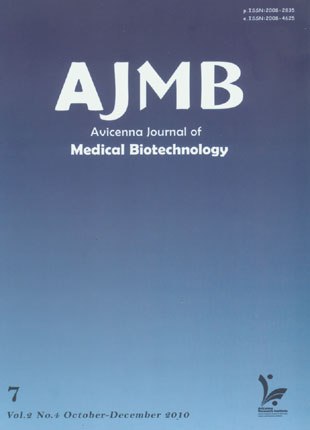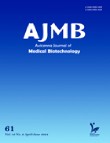فهرست مطالب

Avicenna Journal of Medical Biotechnology
Volume:2 Issue: 4, Oct-Dec 2010
- تاریخ انتشار: 1389/11/02
- تعداد عناوین: 7
-
-
Page 161MicroRNAs (miRNAs) are short RNA molecules which bind to target mRNAs, resulting in translational repression and gene silencing and are found in all eukaryotic cells. Approximately 2200 miRNA genes have been reported to exist in the mammalian genome, from which over 1000 belong to the human genome. Many major cellular functions such as development, differentiation, growth, and metabolism are known to be regulated by miRNAs. Proximity to other genes in the genome and their locations in introns of coding genes, noncoding genes and exons have been reported to have a major influence on the level of gene expressions in eukaryotic cells. miRNAs are well conserved in eukaryotic system and are believed to be an essential and evolutionary ancient component of gene regulatory networks. Therefore, in recent years miRNAs have been studied as a likely candidate for involvement in most biologic processes and have been implicated in many human diseases.
-
Page 181Lentinan a polysaccharide from medicinal mushroom i.e Lentinus, has been known to have anticancer properties. Telomerase activity is not observed in normal healthy cells, whereas in cancerous cells telomerase expression is high. Telomerase represents a promising cancer therapeutic target. We investigated the inhibitory effect of lentinan on telomerase reverse transcriptase gene (hTERT) which is essential for telomerase activity. To assess the transcriptional effect, DLD -1 cancer cells were cultured in the presence of various concentrations of lentinan. TRAP assay, RT-PCR analysis were performed to find telomerase activity and hTERT gene expression respectively. Since C-myc is known to regulate hTERT, expression of C-myc was also determined. Culturing cells with lentinan resulted in down regulation of hTERT and C-myc expression.These results indicate that lentinan inhibits telomerase activity by down regulating hTERT expression via suppression of C-myc in cancer cells
-
Page 187Studies on biomedical applications of nanoparticles are growing with a rapid pace. In medicine, nanoparticles may be the solution for multi-drug-resistance which is still a major drawback in chemotherapy of cancer. In the present study, we investigated the potential cytotoxic effect of silver nanoparticles (Ag NPs) and silver ions (Ag+) in both parent and tamoxifen-resistant T47D cells in presence and absence of tamoxifen. Ag NPs were synthesized (< 28 nm) and MTT assay was carried out. The associated IC50 values were found to be: 6.31 g/ml for Ag NPs/parent cells, 37.06 g/ml for Ag NPs/tamoxifen-resistant cells, 33.06 g/ml for Ag+/parent cells and 10.10 g/ml for Ag+/resistant cells. As a separate experiment, the effect of subinhibitory concentrations of Ag NPs and Ag+ on the proliferation of tamoxifen resistant cells was evaluated at non-toxic concentrations of tamoxifen. Our results suggested that in non-cytotoxic concentrations of silver nanomaterials and tamoxifen, the combinations of Ag+-tamoxifen and Ag NPs-tamoxifen are still cytotoxic. This finding may be of great potential benefit in chemotherapy of breast cancer; since much lower doses of tamoxifen may be needed to produce the same cytotoxic effect and side effects will be reduced.
-
Page 197To accomplish the worldwide demand for recombinant human erythropoietin (rHuEpo) as a therapeutic, application of cost-efficient expression system of methylotrophic yeast Pichia pastoris (P. pastoris) rather than mammalian cells is indispensable. Herein, a report on high levels secreted-expression of Pichia-derived rHuEpo by batch fermentation in a pH stabilized format is presented. The full length cDNA of rHuEpo was inserted into pPICZαA vector under control of AOX1 promoter, downstream of the secretion-α-factor and electroporated into P. pastoris strain X33. The highest expression transformant was selected by screening among the colonies surviving high concentration of Zeocin (1.0 mg/ml), followed by comparative small scale expression analysis by ELISA. Stabilization of pH around 6.0 by adding phosphoric acid into the culture media during induction period, improved the yield of expression to 150 mg/l of the media. Single-step Nickel-affinity chromatography was employed for purification of rHuEpo-6xHis to 80% purity. Analyses by SDS- PAGE, Western blot and N-terminal protein sequencing confirmed the authenticity of the 33 kDa expressed rHuEpo with a native N-terminal indicating the proper cleavage of secretion-signal. Results of this study, further confirmed the possibility of employing methylotrophic yeast for scaled up production aims of rHuEpo as a cost-efficient expression system when provided evidence for higher expression yields through application of pH-controlled systems.
-
Page 207Hepatitis B virus (HBV) infection is the 10th leading cause of death worldwide. The most important diagnostic and screening marker for HBV infection is Hepatitis B surface antigen (HBsAg), and the most widely used HBsAg screening test is Enzyme-linked Immunosorbent Assay (ELISA). In this study, an ELISA assay has been developed for detection of HBsAg using two novel monoclonal antibodies (mAb) as capture layer and a polyclonal biotinylated Ab as detector phase. We evaluated the sensitivity, specificity, detection limit, seroconversion time, positive and negative predictive values and reproducibility of our assay with standard panels and different serum samples. The results were compared with a well established commercial kit. Both assays showed similar detection limit values of 0.5 to 0.7 ng/ml and the same seroconversion periods of 42 and 65 days for “ad” and “ay” serotypes of HBsAg, respectively. Sensitivity and specificity of the assay were 98.98% and 99.6%, respectively. The positive and negative predictive values of our assay were also calculated as 99.49% and 99.2%, respectively. Analysis of reproducibility of the present assay demonstrated 3.96% and 5.85% intra-and inter-assay coefficient of variations, respectively, which were less than those obtained by the commercial kit. There was a highly significant correlation between our designed assay and the commercial ELISA kit (p < 0.0001, r = 0.957). Altogether, our results indicate that the designed assay is comparable to the commercial kit in terms of sensitivity, specificity, positive and negative predictive values and reproducibility and could be employed for diagnosis of HBV infection in blood samples.
-
Page 215Mimosa pudica Lin., known as chue Mue, is a stout straggling prostrate shrubby plant, with spinous stipules and globose pinkish flower heads, and grows as weed in almost all parts of the country. It is traditionally used for its various properties and hence in the present study, chloroform extract of Mimosa pudica leaves has been screened for its hypolipidemic activity. Hypolipidemic activity is screened by inducing hyperlipidemia with the help of atherogenic diet in wistar albino rats and serum levels of various biochemical parameters such as total cholesterol, triglycerides, LDL, VLDL and HDL cholesterol were determined. Atherogenic index shows the measure of the atherogenic potential of the drugs. Chloroform extract showed significant (p < 0.05) hypolipidemic effect by lowering the serum levels of biochemical parameters such as significant reduction in the level of serum cholesterol, triglyceride, LDL, VLDL and increase in HDL level which was similar to the standard drug Atorvastatin. Chloroform extract exhibited significant atherogenic index and percentage protection against hyperlipidemia. These biochemical observations were in turn confirmed by histopathological examinations of aorta, liver and kidney sections and are comparable with the standard hypolipidemic drug Atorvastatin. Preliminary phytochemical analysis revealed the presence of phytoconstituents such as steroids, flavonoids, glycosides, alkaloids, phenolic compounds which is further confirmed by the thin layer chromatography, High Performance Thin Layer Chromatography (HPTLC). The overall experimental results suggests that the biologically active phytoconstituents such as flavonoids, glycosides alkaloids present in the chloroform extract of Mimosa pudica, may be responsible for the significant hypolipidemic activity and the results justify the use of Mimosa pudica as a significant hypolipidemic agent.


